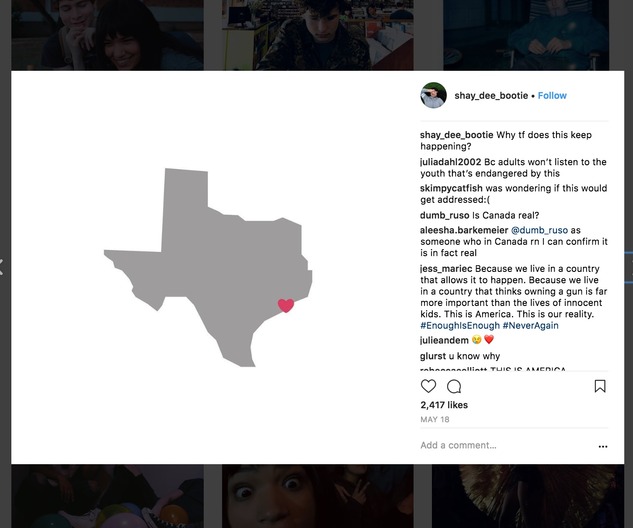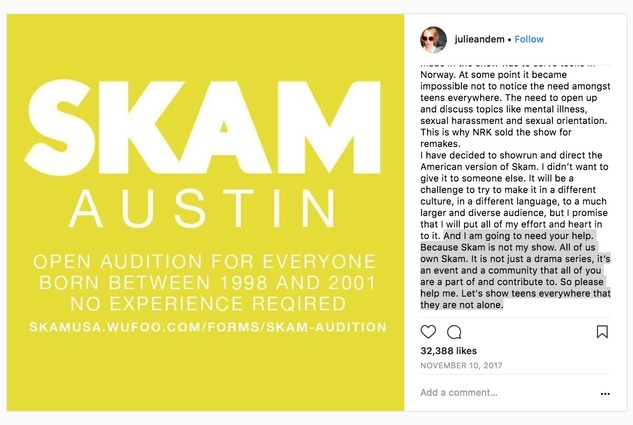Impulse and SKAM Austin: The Newest Teen Davids Taking on the Streaming Goliaths
Photo: Erin Keating/YouTube Premium
I don’t know if you’ve heard, but as of February, digital streamer Netflix was on track to have produced, by the end of 2018, at least 700 original series.
I additionally don’t know if you’ve done the simple arithmetic on that, but conservatively (and somewhat arbitrarily) averaging those originals out to having the equivalent of a single, 13-episode season each—clocking in at another conservative average of 45 minutes per episode—that equals about 6,825 hours of watch time. If you take as your starting point the company’s most recent end-of-year estimate of 1,000 original series, that count balloons to 9,750.
Nearly 10,000 hours.
Available to load directly into your eyeballs.
From whatever screen you have nearest at hand.
So, OK: When it comes to streaming video on demand (SVOD), it is patently obvious that no one in the market can beat Netflix. (To be honest, it’s existentially questionable sometimes if even Netflix can beat Netflix). Thus, it makes sense that when it comes to mounting any kind of bid for audience attention, the competition will have to invest in something other than sheer volume.
Cue YouTube, Facebook, and the two newest teen-oriented gambits the tech companies have each sent charging into the SVOD fray: Impulse (on YouTube Premium) and SKAM Austin (on, for the most part, Facebook Watch). Both remakes of established franchises. Both centered on the painfully isolating social lives of teen girls. Both bracingly compelling. Neither, for completely different reasons, something that Netflix (or, for that matter, Hulu or Amazon) could pull off.
Which, for a professional consumer of (especially teen) television, is exciting.
Of the two, the awkwardly authentic and painfully mundane SKAM Austin is the easiest to understand as novel. The fourth of six planned international remakes of Julie Andem’s viral Norwegian public television hit, SKAM (following Italy, France, and Germany, and preceding Spain and the Netherlands), SKAM Austin is less a “series” than it is an obsession-inducing transmedia experience: Launching with zero fanfare on April 24, it began following the lives of Austin, Tex. sophomore Megan (Julie Rocha) and her boyfriend, friends, and enemies in excruciatingly real real-time, with clips of their quotidian modern teenage dramas posting daily to the Facebook Watch newsfeed at the exact moment each scene went down, and with the production team maintaining live, interactive Instagram accounts belonging to each character for fans to follow in between newsfeed drops.
Throughout what has amounted to the first season (with as little fanfare as the series began, Megan’s big character arc seemed to wrap up with the scene posted at 4:04 p.m. on June 15; no new scenes have posted since), these individual clips were compiled at the end of each week to create a more familiar kind of “episode,” title sequence and credits included. In fact, dear reader, if you jump immediately from the end of this column over to the official SKAM Austin Facebook page, you’ll be nudged by the playlist pinned to the top of the feed to settle in for a Netflix-style binge of those very compilations.
But to watch only the full-length “episodes” is to miss the most important and structurally unique parts of the SKAM-franchise experience: The genuine real-time anxiety of obsessing over how each new twist in the social network will work itself out, and the equally genuine real-time bonding as SKAM fans join the characters in stalking Megan et al’s IGs looking for hidden clues that might untangle (or introduce new) interpersonal twists to the fleeting moments of IRL interaction we’re fed back on Facebook Watch. (Bonus jolts of adrenaline available for anyone monstrous enough to turn IG and Facebook notifications on for however many weeks an arc takes to play out.)
Of course, the original clips of Megan’s story exist in situ in the series’ feed, so you could opt to scroll past the pinned playlist and start from the beginning, taking mini IG breaks in between daily scenes to do some solo sleuthing. But even then there are crucial real-time experiences that you will miss, like the fact that the mysterious “CALL ME” comment from Megan’s ex-BFF, Abby (Sophia Hopkins), appeared live under one of Marlon’s (Till Simon) IG posts long before the day’s scene posted, and then disappeared in the real world at the same time as it disappeared from Megan’s screen on the show. Or the fact that Megan and Marlon attended a Kendrick Lamar concert from his current Championship Tour. Or the surreal jolt of disoriented recognition fans felt seeing SKAM Austin characters react in infuriated sadness to the Santa Fe school shooting as it happened.
In the case of the latter, character Shay’s (La’Keisha Slade) caption of “Why tf does this keep happening?” elicited the full spectrum of line-blurring responses—not just teen revolutionaries (“Because we live in a country that allows it to happen. Because we live in a country that thinks owning a gun is far more important than the lives of innocent kids. This is America. This is our reality. #EnoughisEnough #NeverAgain”) and nihilists (“u know why”) and gun rights kids with counterarguments all taking Shay seriously, but also metafictional comments about the show using Shay’s fictional IG to comment on real breaking news (one fan responding “another school shooting” to another who asked about what happened and getting “oh i thought it was skam related, i feel bad now >.<” in response; “was wondering if this would get addressed : (” from another fan later on). To add further distortion of reality to the equation, even the showrunner herself (julieandem in the screenshot above) weighed in with an all-emoji show of support.
All of these interactions are still available for anyone picking the show up now to take in as historical artifacts—in fact, Facebook’s ownership of IG allowed it to backlog each of the characters’ accounts with reality-establishing posts dating back to 2017, before the first scene of the series even dropped—but without the real-time interactions between each of the characters throughout the official season, the full effect is dampened.
Plus there is the fact, reported in a recent profile in The New Yorker, that Andem’s creative team actively takes the audience’s reactions and thoughts into consideration as they develop the next batch of scenes. This promise of fan collaboration was underscored in Andem’s IG post announcing the SKAM Austin project and casting: “[SKAM] is not just a drama series, it’s an event and a community that all of you are a part of and contribute to.” Miss the original, live run of clips, and you miss out on that prospect of communal creation.
If any of this sounds familiar to you, it’s likely because independent filmmakers on YouTube were doing this kind of storytelling as far back as 2012—starting with Hank Green and Bernie Su’s Creative Emmy-winning Pride and Prejudice adaptation, The Lizzie Bennet Diaries (in which the character, like those on SKAM Austin, had active social media accounts), and continuing on through the equally interactive properties of Emma Approved, Frankenstein, MD, Carmilla, and the remarkably SKAM-like Nothing Much to Do, from New Zealand outfit The Candle Wasters, whose awkward naturalism will feel especially familiar to anyone who spent the last eight weeks cringing through Megan’s misadventures in Austin.
All this is to say: What Julie Andem and SKAM Austin are doing at Facebook isn’t new. It’s just a more mainstream, less vloggy evolution of something scrappy indie filmmakers on (but not being employed by) YouTube have been doing for the past half dozen years, produced with the kind of platform, budget and strategy that can take a slow-burning story like Megan’s and turn it into an oblique, dynamic challenge that streamers like Netflix, Hulu and Amazon—services which have no social feeds to interrupt, no comments sections to open up to fans, and few shows their audience will tolerate having doled out one episode at a time—can’t ever hope to match.
YouTube, for its part, is taking an entirely different tack in mounting its own challenge to the streaming giants.
Impulse, the media-cum-tech platform’s newest in-house produced science fiction series, starring Maddie Hasson as an isolated teen girl new to town and even more newly afflicted with mysterious and destructive teleportation abilities, is the very opposite of scrappy. It is not a vlog. It is not transmedia. It has not employed a fleet of real teens as a strategy to be more realistic and relatable. It is full-on Hollywood, with the top-level cast (Missi Pyle, Danny Pudi, Daniel Maslany), production values (find a way to watch this on the biggest screen possible), and creative production team (Doug Liman, Jeffrey Lieber, Lauren LeFranc) on board to prove it.
What Impulse reads as, both in the trailer above and within the first five harrowingly cinematic minutes of the pilot episode (in which, suffice it to say, Keegan-Michael Key does not have a great day), is exactly what it is: A significant creative investment with which YouTube hopes to turn YouTube Premium—and by deeper extension, Google—into a player in the prestige drama space. It is YouTube’s answer to Orange is the New Black, or to Transparent, or to The Handmaid’s Tale.
At least, it hopes to be. Having watched all 10 episodes (the last seven of which are behind the YouTube Premium paywall), I absolutely think it is good enough to be. Hasson is electrifying as Henry Coles, which is a feat considering how terse Henry is, and how tightly wound into herself. Her lows are all-consuming, but her highs are infectious—you never wonder for a minute why basketball star Clay (Tanner Stine), autistic science whiz Townes (Daniel Maslany), and even her put-upon proto-stepsister Jenna (Sarah Desjardins) would be so magnetically drawn to her, even as she fends them all off with barely figurative knives. And while the lean adult grace of Hasson’s face belies the fact that she is the typical twentysomething only playing at sixteen, her every transparently hurt interaction with mom Cleo (Missi Pyle) is so wholly juvenile that you’ll keep checking IMDb to confirm she was, in fact, born before Y2K.
Pyle as Cleo is equally exquisite, playing a straight dramatic role that anyone who fell in love with her in Galaxy Quest or Dodgeball will be shocked in the best way to see her pull off, but it’s not just the Coles women who shine. Every side character in Reston has a complex story that develops with care across the first season’s 10 episodes—Jenna’s exploration of her confidence and sexuality, Lucas Boone’s (Craig Arnold) emergence from a lifetime of being gaslit into doing evil, and Deputy Anna Hulce’s (Enuka Okuma) traversal of professional grief in a sea of corruption are particular standouts. But even the one-off characters like Amadeus Serafini’s Josh and Lois Smith’s Dippy deliver gut punches of emotional complexity. Plot-wise, the bits of the bigger conspiracy we see happening outside of Henry’s geographic sphere are tantalizing without threatening to suffocate Henry’s personal story, while the speed with which Henry grows to understand and control her ability (or not) is realistically slow and halting. Most critically, though, the sexual assault that triggers Henry’s teleportation powers to begin with—and the ways in which that trauma lingers without end date—is handled with the most care I’ve seen on television apart from Sweet/Vicious.
On top of all this (and at some point, I’m going to have to make a list for as often as I’ve said this this year): The punk-infused soundtrack bangs.
So how does this series, which tracks so completely with the model of other prestige tentpoles across the digital (and linear) space, rate as a project that can challenge Netflix and the rest from a novel angle?
Well, it starts with the audience YouTube already has built-in: Young, constantly streaming, and game to click over from their favorite YouTube influencers’ channels when Impulse character Dominick (Keon Alexander) teleports in and out of said influencer’s latest video (like at 1:30 in the clip below)—and to then interact in the show’s comments section as Henry’s story unfolds.
It continues with the fact that Bourne franchise’s Doug Liman—who not only produced and directed the pilot but also produced the original Jumper film, which was based on the same series of books as is Impulse—already had a habit of using the crazy stunts pulled off by real people on YouTube as part of his creative development process. That is to say, the kinds of stunts we see on Impulse are a direct result of, you know, that one video you saw that one time? Where that dude did that THING??
Beyond stunts, though, is the fact that the tone Liman wanted for Henry’s alt-universe version of the Jumper mythology was one that was as quiet and personal as a superpower-free indie film—or, as the case may be, as your favorite experimentally introspective vlogger. “YouTube is nothing but indie filmmakers,” he explained in a recent BUILD Series interview as he and Hasson did press for the show, “and yet it’s also one of the biggest corporations in the world, so it also has the kind of glossy veneer. So what I wanted to do with Impulse, it was tonally perfect for YouTube.”
This might sound like a silver-tongued bit of press bait, but the first sentence I wrote when drafting notes for this piece was: YouTube’s rise to prominence came on the backs of teens cracking open their inner lives for the world; Impulse turns that dynamic on its head by examining the inner lives of teens through really nuanced silences and isolation—plus teleportation. If that was Liman’s goal, he absolutely succeeded. Moreover, it’s a testament to the kind of television that can only be produced at YouTube, as no other streaming service or media platform has the same indie-film, community-based institutional legacy. If YouTube has its way, Impulse will just be the start.
Now, whether SKAM Austin or Impulse continue on past their first seasons, that’s still up in the air. But while there’s been no official word on either, the Norwegian version of SKAM ran for four seasons, Megan’s arc ended with an enormous cliffhanger reveal that OG stans flooding the Facebook Watch comments immediately recognized, and Andem herself moved across an ocean to produce it, so it seems impossible more installments of SKAM Austin aren’t to come. Impulse, too, ended on an acute twist of a cliffhanger that cracked Henry’s world bloodily open—plus, in that same BUILD series video above, Hasson stated with a little too much confidence that they were coming back when the prospect came up.
Whatever happens, you will lose nothing if you get on board with both shows now. They are both terrific.
Alexis Gunderson is a TV critic whose writing has appeared on Forever Young Adult, Screener, and Birth.Movies.Death. She’ll go ten rounds fighting for teens and intelligently executed genre fare to be taken seriously by pop culture. She can be found @AlexisKG.









































